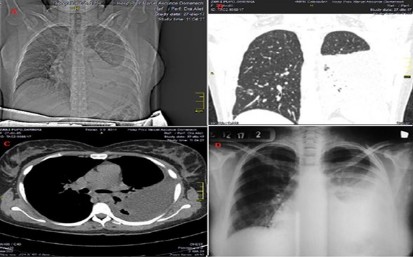Use of intrapleural recombinant streptokinase in a pregnant woman with pleural empyema
Abstract
Background: pneumonia complicates 0,78-2,7 per 1 000 pregnancies placing the mother and the fetus at risk. Empyema as a complication of pneumonia in a pregnant patient adds a high rate of morbidity and mortality to the mother and the fetus if one does not act quickly.
Objective: to present the case of a pregnant woman of 33 weeks who developed a pleural empyema resulting from acquired pneumonia.
Clinical case: 33-week gestated patient, asthmatic admitted to the intensive care unit of the University Hospital Manuel Ascunce Domenech with the diagnosis of severe pneumonia acquired in the community complicated with para-pneumonic effusion, which evolved into empyema. It was treated with a thoracotomy tube and fibrinolytic therapy, with good clinical and radiological evolution.
Conclusions: Recombinant streptokinase can be used safely and effectively for the management of PE, as an intrapleural fibrinolytic agent, during pregnancy.
DeCS: PREGNANCY COMPLICATIONS; STREPTOKINASE/therapeutic use; EMPYEMA, PLEURAL/DRUG THERAPY; EMPYEMA, PLEURAL/ complications; FIBRINOLYTIC AGENTS/therapeutic use.
Downloads
References
1. Munnell ER. Thoracic drainage. Ann Thorac Surg. 1997;63(5):1497-502.
2.Miller JI. The history of surgery of empyema, thoracoplasty, Eloesser flap, and muscle flap transposition. Chest Surg Clin N Am. 2000;10(1):45-53.
3.Burgess JR, Smith B, Britt R, Weireter L, Polk T. Predicting Postoperative Complications for Acute Care Surgery Patients Using the ACS NSQIP Surgical Risk Calculator. Am Surg. 2017;83(7):733-8.
4.Oshodi T, Carlan SJ, Busowski M, Sand ME. Video assisted thoracic surgery in a second trimester pregnant woman with thoracic empyema: a case report. J Reprod Med. 2015;60(3-4):172-4.
5.Liao JP, Wang GF, Jin Z, Qian Y, Deng J, Que CL. Severe pneumonia caused by adenovirus 7 in pregnant woman: Case report and review of the literature. J Obstet Gynaecol Res. 2016;42(9):1194-7.
6.Altmann E. Efficacy of intrapleural instillation of fibrinolytics for treating pleural empyema and parapneumonic effusion: appropriateness of including paediatric trials in meta-analysis. Clin Respir J. 2016;10(5):676.
7.Zago M, Bozzo S, Carrara G, Mariani D. Failure to Rescue, Rescue Surgery and Centralization of Postoperative Complications: A Challenge for General and Acute Care Surgeons. Chirurgia (Bucur). 2017;112(5):538-45.
8.Reichert M, Hecker M, Witte B, Bodner J, Padberg W, Weigand MA, et al. Stage-directed therapy of pleural empyema. Langenbeck Arch Surg. 2017;402(1):15-26.
9.Redden MD, Chin TY, van Driel ML. Surgical versus non‐surgical management for pleural empyema. Cochrane Database of Systematic Reviews [Internet]. 2017 [citado 22 Ago 2018];3(CD010651):[aprox. 59 p.]. Disponible en: https://www.cochranelibrary.com/cdsr/doi/10.1002/14651858.CD010651.pub2/full
10. Rahman NM. Intrapleural agents for pleural infection: fibrinolytics and beyond. Curr Opin Pulm Med. 2012;18(4):326-32.
11.Birkenkamp K, O'Horo JC, Kashyap R, Kloesel B, Lahr BD, Daniels CE, et al. Empyema management: A cohort study evaluating antimicrobial therapy. J Infect. 2016;72(5):537-43.
12.Dabo H, Meira L, Neves I, Marinho A, Gomes I. Combined intrapleural therapy in infectious pleural effusion. Rev Port Pneumol. 2015;21(2):105-6.
13.Ferreiro L, San Jose ME, Valdes L. Management of Parapneumonic Pleural Effusion in Adults. Arch Bronconeumol. 2015;51(12):637-46.
14.Tillett WS, Sherry S. The effect in patients of streptococcal fibrinolysin and streptococcal desoxyribonuclease on fibrinous, purulent, and sanguinous pleural exudations. J Clin Invest. 1949;28(1):173-90.
15.Idell S, Florova G, Shetty S, Tucker T, Idell R, Koenig K, et al. Precision-guided, Personalized Intrapleural Fibrinolytic Therapy for Empyema and Complicated Parapneumonic Pleural Effusions: The Case for the Fibrinolytic Potential. Clin Pulm Med. 2017;24(4):163-9.
16.Nie W, Liu Y, Ye J, Shi L, Shao F, Ying K, et al. Efficacy of intrapleural instillation of fibrinolytics for treating pleural empyema and parapneumonic effusion: a meta-analysis of randomized control trials. Clin Respir J. 2014;8(3):281-91.
17.Breen DP, Daneshvar C. Role of interventional pulmonology in the management of complicated parapneumonic pleural effusions and empyema. Respirology. 2014;19(7):970-8.
18.Raymond D. Surgical intervention for thoracic infections. Surg Clin North Am. 2014;94(6):1283-303.
19.Worrell SG, Demeester SR. Thoracic emergencies. Surg Clin North Am. 2014;94(1):183-91.
20.Davies HE, Davies RJ, Davies CW, Group BTSPDG. Management of pleural infection in adults: British Thoracic Society Pleural Disease Guideline 2010. Thorax. 2010;65 Suppl 2: 41-53.

Published
How to Cite
Issue
Section
License
Copyright: Camagüey Medical Archive Magazine, offers immediately after being indexed in the SciELO Project; Open access to the full text of the articles under the principle of making available and free the research to promote the exchange of global knowledge and contribute to a greater extension, publication, evaluation and extensive use of the articles that can be used without purpose As long as reference is made to the primary source.
Conflicts of interest: authors must declare in a mandatory manner the presence or not of conflicts of interest in relation to the investigation presented.
(Download Statement of potential conflicts of interest)
The Revista Archivo Médico de Camagüey is under a License Creative Commons Attribution-Noncommercial-No Derivative Works 4.0 International (CC BY 4.0).
This license allows others to distribute, to mix, to adjust and to build from its work, even for commercial purposes, as long as it is recognized the authorship of the original creation. This is the most helpful license offered. Recommended for maximum dissemination and use of licensed materials. The full license can be found at: https://creativecommons.org/licenses/












 22 julio 2025
22 julio 2025